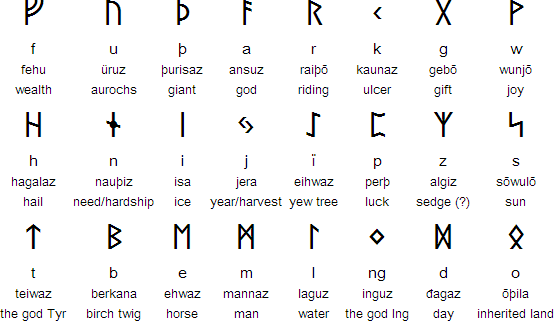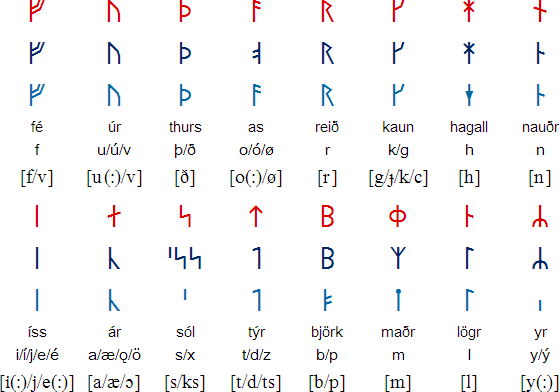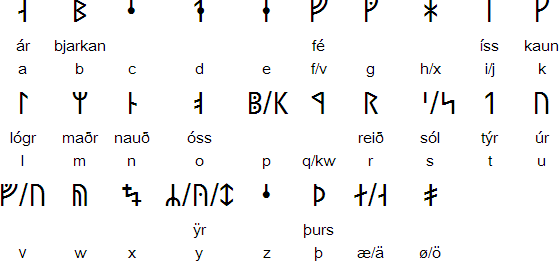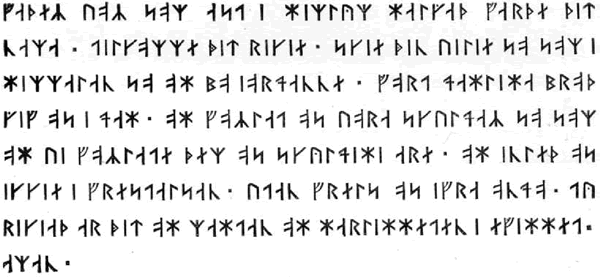Little is known about the origins of the Runic alphabet, which is traditionally known as futhark after the first six letters.
The Runic alphabet may have been based on an early version of the Greek alphabet. A number of letters resemble those used in early Greek alphabet. Alternatively it may have developed from one of the ancient alphabets used in Italy for Etruscan or other languages.
The earliest known Runic inscriptions date from the 1st century AD, but the vast majority of Runic inscriptions date from the 11th century. Runic inscriptions have been found throughout Europe from the Balkans to Germany, Scandinavia and the British Isles.
The word rune comes from the Old Norse word rún (secret, runic letter), from the Proto-Norse ᚱᚢᚾᛟ runo (secret, mystery, rune), from the Proto-Germanic rūnō (secret, mystery, rune), from Proto-Indo-European *rewHn- (to roar; grumble; murmur; mumble; whisper) [source].
There are a number of different Runic alphabets including:
Elder Futhark is thought to be the oldest version of the Runic alphabet, and was used in the parts of Europe which were home to Germanic peoples, including Scandinavia. Other versions probably developed from it. The names of the letters are shown in Common Germanic, the reconstructed ancestor of all Germanic languages.
Elder Futhark is also known as Fuþark, Older Futhark, Old Futhark or Germanic Futhark.

The letter k is also called kēnaz (torch) or kanō (skiff). The meaning of the letter name perþ is unknown.
More information about Elder Futhark
https://en.wikipedia.org/wiki/Elder_Futhark
http://www.therunesite.com/elder-futhark-rune-meanings/
Younger Futhark or "Normal Runes" gradually evolved Elder Futhark over a period of many years and stabilized by about 800 A.D., the beginning of the Viking Age. It was the main alphabet in Norway, Sweden and Denmark throughout the Viking Age, but was largely though not completely replaced by the Latin alphabet by about 1200 as a result of the conversion of most of Scandinavia to Christianity.
Three slightly different versions of the alphabet developed in Denmark, Norway and Sweden - the first row of runes are the Danish ones, the second row are the Norwegian ones, and the third row are the Swedish ones, which are also known as Short-twig or Rök Runes.

These runes were used in Gothenburg in Sweden.

More information about Younger Futhark
https://en.wikipedia.org/wiki/Younger_Futhark
https://www.vikingrune.com/2008/11/younger-futhark-runes/
http://www.therunesite.com/younger-futhork-rune-meanings/
After the arrival of Christianity in Scandinavia, the Runic alphabet was Latinised and was used occasionally, mainly for decoration, until 1850. They are also known as futhork.

More information about Medieval Futhark
https://en.wikipedia.org/wiki/Medieval_runes
Thanks to Niklas Dougherty for some of the information on this page.

Faðer uor som ast i himlüm, halgað warðe þit nama. Tilkomme þit rikie. Skie þin uilie so som i himmalan so oh bo iordanne. Wort dahliha broð gif os i dah. Oh forlat os uora skuldar so som oh ui forlate þem os skuüldihi are. Oh inleð os ikkie i frestalsan utan frels os ifra ondo. Tü rikiað ar þit oh mahtan oh harlihheten i ewihhet. Aman.
Source: www.christusrex.org/www1/pater/JPN-norse-old.html
Hear the Lord's Prayer in Old Icelandic (not quite the same as the above text, but similar):
Information about Old Norse | Numbers | Tower of Babel | Learning materials
Download these alphabet charts (Excel speadsheet)
Books about Runes and Runic scripts
Information about the Runic alphabets
https://en.wikipedia.org/wiki/Runes
https://www.scandinavianarchaeology.com/all-about-the-futharks/
http://www.arild-hauge.com/eindex.htm
https://runicstudies.org/runic-resources/
An English Dictionary of Runic Inscriptions of the Younger Futhark
http://runic-dictionary.nottingham.ac.uk/
Rune Translator
https://valhyr.com/pages/rune-translator
Runic Inscriptions
https://en.wikipedia.org/wiki/Runic_inscriptions
https://emidsvikings.ac.uk/resources/runes-and-runic-inscriptions/
Runes Secrets - How to Use the Elder Futhark Runes
http://runesecrets.com
Runic fonts
https://fonts.google.com/noto/specimen/Noto+Sans+Runic
https://www.babelstone.co.uk/Fonts/index.html
Your name in runes
http://www.pbs.org/wgbh/nova/vikings/runes.html
ALPHABETUM - a Unicode font
for ancient scripts, including Classical & Medieval Latin, Ancient Greek, Etruscan, Oscan, Umbrian, Faliscan, Messapic, Picene, Iberian, Celtiberian, Gothic, Runic, Old & Middle English, Hebrew, Sanskrit, Old Nordic, Ogham, Kharosthi, Glagolitic, Anatolian scripts, Phoenician, Brahmi, Imperial Aramaic, Old Turkic, Old Permic, Ugaritic, Linear B, Phaistos Disc, Meroitic, Coptic, Cypriot and Avestan.
https://www.typofonts.com/alphabetum.html
Elder Futhark, Younger Futhork, Medieval (Latinised) Futhark, Dalecarlian Runes, Anglo-Saxon Runes
A-chik Tokbirim, Adinkra, ADLaM, Armenian, Avestan, Avoiuli, Bactrian, Bassa (Vah), Beitha Kukju, Beria (Zaghawa), Borama / Gadabuursi, Carian, Carpathian Basin Rovas, Chinuk pipa, Chisoi, Coorgi-Cox, Coptic, Cyrillic, Dalecarlian runes, Elbasan, Etruscan, Faliscan, Fox, Galik, Georgian (Asomtavruli), Georgian (Nuskhuri), Georgian (Mkhedruli), Glagolitic, Global Alphabet, Gothic, Greek, Hurûf-ı munfasıla, Irish (Uncial), Kaddare, Kayah Li, Khatt-i-Badíʼ, Khazarian Rovas, Koch, Korean, Latin, Lepontic, Luo Lakeside Script, Lycian, Lydian, Manchu, Mandaic, Mandombe, Marsiliana, Medefaidrin, Messapic, Mongolian, Mro, Mundari Bani, Nag Chiki, Naasioi Otomaung, N'Ko, North Picene, Novo Tupi, Nyiakeng Puachue Hmong, Odùduwà, Ogham, Old Church Slavonic, Oirat Clear Script, Ol Chiki (Ol Cemet' / Santali), Old Italic, Old Nubian, Old Permic, Ol Onal, Orkhon, Osage, Oscan, Osmanya (Somali), Pau Cin Hau, Phrygian, Pollard script, Runic, Székely-Hungarian Rovás (Hungarian Runes), South Picene, Sutton SignWriting, Sunuwar, Tai Viet, Tangsa, Todhri, Toto, Umbrian, (Old) Uyghur, Wancho, Yezidi, Zoulai
Page last modified: 18.12.23
[top]
You can support this site by Buying Me A Coffee, and if you like what you see on this page, you can use the buttons below to share it with people you know.

If you like this site and find it useful, you can support it by making a donation via PayPal or Patreon, or by contributing in other ways. Omniglot is how I make my living.
Note: all links on this site to Amazon.com, Amazon.co.uk
and Amazon.fr
are affiliate links. This means I earn a commission if you click on any of them and buy something. So by clicking on these links you can help to support this site.
[top]